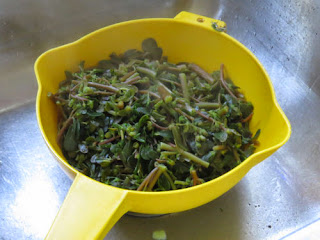Common purslane, Portulaca oleracea, is grown as a vegetable in many cultures, but in the United States it is usually considered a weed. What a weed! You can easily get several servings of vegetables from one healthy plant, for free! The plant is an annual.
Identification is relatively easy. Look for this plant, also known as hogweed, in disturbed soils. It grows in a flat rosette, radiating in a slightly off-center manner. The stems are reddish and the entire plant has a somewhat succulent appearance. You can gather it throughout the summer, up through the time it has tight buds. The earlier pickings will be more tart. When the buds form, the flavor becomes milder.
It can be eaten raw, or cooked in several ways. Today, I boiled the leaves and stems and ate them as a green.
Pull up the entire plant, or cut the stems at the base. Wash thoroughly and pull off wilted or sunburned leaves. Tight buds are fine to eat, and won't change the flavor.
 yield from three purslane plants (photo by jhy) yield from three purslane plants (photo by jhy) |
I like to use scissors, because it's a very easy way to cut the plant into pieces of similar size. I cut the largest stems into sections 1 to 1.5 inches long and throw them into boiling water first. Then I continue with the smaller stems and leaves. Boil until cooked to taste. I prefer them slightly crunchy, 2-5 minutes.
Rinse and serve immediately with your preferred condiment (oil, salt, etc), or eat plain.
Early plants will have a tart, citrus taste. They remind me of beet stems.
Purslane contains more omega-3 fatty acids than any other leafy vegetable, more than some fish. It is also high in vitamins A,C and E, and magnesium, calcium, potassium, and iron. Anti-oxidant properties come from betacyanins and betaxanthins present in the plant.
It is high in oxalate, which can contribute to kidney stone formation, but cooking reduces that risk, and many vegetables we eat regularly contain oxalates. As with any food, it makes sense to vary the menu.


